Groundwater Organizations Promote Aquifer Stewardship for U.S. Agriculture

Almost two-thirds of all irrigated U.S. agricultural acreage relied on groundwater as a primary or secondary source of water in 2018, according to data from USDA’s National Agricultural Statistics Service (NASS). The shared nature of many groundwater resources means pumping by one irrigator affects water availability for nearby irrigators. That connectivity led to the creation of groundwater management districts, natural resource districts, groundwater sustainability agencies, and other groundwater management entities. These organizations play a critical role in determining the future of groundwater-based irrigated agriculture, but national data about their functions has only recently become available.
The 2019 Survey of Irrigation Organizations (SIO) is the first nationally representative Federal data collection effort aimed at organizations that deliver water to farms or influence on-farm groundwater withdrawals. Three USDA agencies (Economic Research Service, NASS, and the Office of the Chief Economist) collaborated to develop and implement the survey.
According to SIO data, there were 735 groundwater organizations in the United States in 2019. Of these, 601 report delivering water to irrigated farms and ranches in addition to engaging in groundwater management (“groundwater and delivery”). The remaining 134 organizations focus solely on managing groundwater resources (“groundwater only”).
Groundwater-only organizations often promote groundwater stewardship by monitoring groundwater conditions, collecting pumping data, and issuing permits for well development. More than 75 percent of groundwater-only organizations monitor groundwater conditions or collect pumping data, but 38 percent of groundwater and delivery organizations engage in these activities. Sixty-one percent of groundwater-only organizations issue permits for well development, but less than 10 percent of groundwater and delivery organizations are involved in well-permitting.
Groundwater organizations that also engage in water delivery are more likely to charge pumping or water rights fees compared with organizations that focus solely on groundwater management. The majority (55 percent) of groundwater and delivery organizations report charging pumping fees. A relatively smaller share (40 percent) of groundwater-only organizations uses pumping or water rights fees to support groundwater management objectives.
Irrigation Organizations: Groundwater Management, by Aaron Hrozencik, Grant Gardner, Nicholas Potter, and Steven Wallander, ERS, April 2023
Irrigation & Water Use, by Aaron Hrozencik, USDA, Economic Research Service, September 2023
Irrigation Organizations: Drought Planning and Response, by Steven Wallander, Aaron Hrozencik, and Marcel Aillery, ERS, January 2022
Irrigation Organizations: Water Storage and Delivery Infrastructure, by Aaron Hrozencik, Steven Wallander, and Marcel Aillery, ERS, October 2021
Trends in U.S. Irrigated Agriculture: Increasing Resilience Under Water Supply Scarcity, by Aaron Hrozencik and Marcel Aillery, ERS, December 2021
Climate Change, Water Scarcity, and Adaptation in the U.S. Fieldcrop Sector, by Elizabeth Marshall, Marcel Aillery, Scott Malcolm, and Ryan Williams, ERS, November 2015
The Role of Conservation Programs in Drought Risk Adaptation, by Steven Wallander, Marcel Aillery, Daniel Hellerstein, and Michael S. Hand, USDA, Economic Research Service, April 2013
Some Irrigation Organizations Rely on Formal Drought Plans, by Steven Wallander, Aaron Hrozencik, and Marcel Aillery, USDA, Economic Research Service, February 2022
Irrigation Organizations Use Conveyance Infrastructure To Deliver Water to Irrigated Farms and Ranches, by Aaron Hrozencik, Steven Wallander, and Marcel Aillery, USDA, Economic Research Service, November 2021


